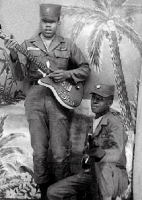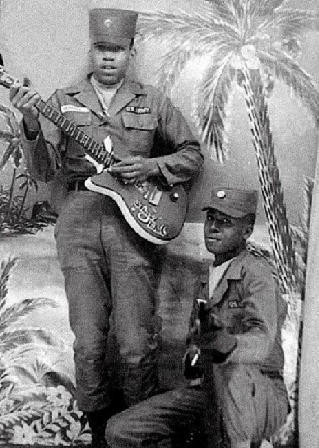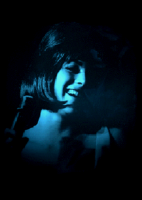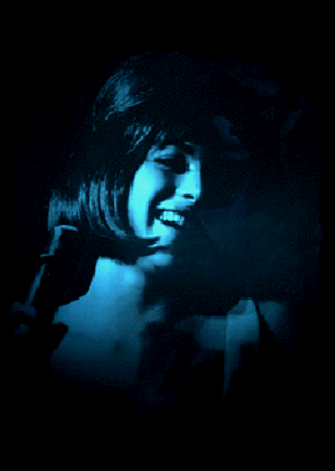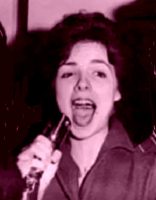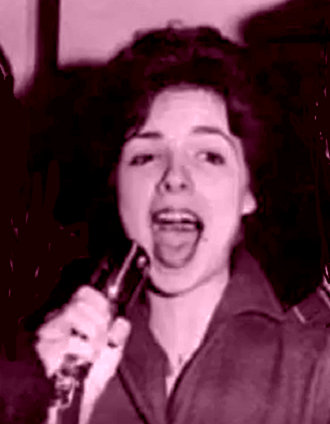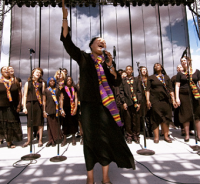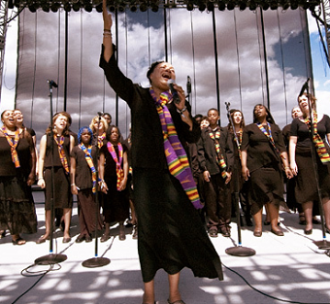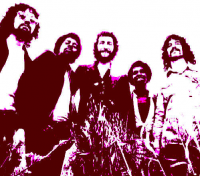
LeRoy Bell made his first appearance on Fox network’s talent show The X Factor in September 2011 He appeared on the show for five consecutive weeks eventually ended up being chosen for the final 16 and went on to the live X-Factor shows. He was eliminated after the fifth live show finishing 8th overall in the inaugural season of the American version of the show. bottom three Although he did not win LeRoy’s profile was sent into the stratosphere (by the way…whatever happened to season one’s winner Melanie Ann Amaro?).
Although LeRoy had captured the imagination of many viewers via The X-Factor, and the show had kick-started his career rather than launched it, Bell had already had a brush with fame. In fact he’d had several…first with the 70’s chart topping duo Bell and James and their hit “Livin’ It Up (Friday Night)” The song ended up at number 15 in the Billboard Charts. He was also a co-author of Elton John’s hit “Mama Can’t Buy You Love” (a world-wide hit which became a top-ten hit in the US) Three Way Love Affair” and “Are You Ready For Love” He’d also co-written songs for The O’Jays, Rita Marley, The Temptations, The Spinners, Freda Payne The Three Degrees, and a host of others.
LeRoy didn’t become an overnight success because of his X-Factor appearance…but it was a chance for him to perform in front of a massive audience.. He’d spent much of the 2000s touring with the likes of BB King Etta James, Sheryl Crow, Leon Russell, Joan Osborne, B.B King, Etta James, Al Green, Joe Cocker, Michael McDonald, Van Morrison, Mavis Staples, The Temptations, The O’jays and more. Whether he’d won or lost The X-Factor made little difference, but he seems grateful and it managed to get a whole new audience. The US version of The X-Factor lasted only two seasons, but he may be the most memorable artist of either one of them.
“It turned out to be a good thing in many ways. It was definitley an eye-opener and interesting to see how TV is totally different than the side of music that I’d grown up with. It was nerve-wracking. I was the oldest guy on the show”.
“The unique thing about the X-Factor is they have no age limit. Most of these things like American Idol are all centered on age people I think you couldn’t be over 30 years old, So here was a show that you didn’t have to be a certain age, so it opened up a lot of things. It was fun in that way”
Much was made at the time that LeRoy was 59 years old, even though he looked half that age; not in a baby-faced way, but as a confident, soft-spoken man who’d also seen a lot of what the world was about. It seems to have been both a curse and a boon to him. Constantly being reminded of his looks must have reinforced our reliance and the importance of youth-culture. Even today at 66 and with the look of a man half his age it’s hard not to notice that LeRoy Bell must have been blessed with good genes…and those genes didn’t seem to reflect only his looks.
One drawback of appearing on the show was he was forced to sing familiar songs by other artists rather than the U.K. show. LeRoy’s voice got him attention and his presentation was great but his real strength was in his songwriting. Unfortunately he had to perform songs by more familiar figures like Bill Withers (Lean on Me), U2 (I Still Haven’t Found What I’m Looking For), Sarah McLachlan ‘Angel’).and a knock-em-dead performance of the Beatles’ “Don’t Let Me Down”
But let’s go back to the beginning.
Leroy Bell was born on born August 8,1951 in Pensacola Florida, but found himself living in Germany the first few years of his life. His father was in the US Army, and he admits he was an “army brat”
“I got my first guitar when I was 13”. He says “ I thought I was going to play guitar, but ended up playing drums. Back in those days we didn’t have amplifiers but we had tape recorders that we used to use as amplifiers. I played with German guys because I went to a German school. My dad wanted me to learn a language, so I didn’t go to the base school.. At the time we were at the US base in Darmstadt,Germany, but we moved around a lot”
In 1966 LeRoy’s father retired from the Army, and settled in the Northwest. It wasn’t until he was a teenager in Seattle that his grandfather told LeRoy his uncle was Thom Bell, one of the most prominent producers, arrangers and songwriters of the wildly popular “Philly Sound”. Thom Bell. along with producers Kenny Gamble and Leon Huff created a sound that blended soulful harmonies, lush arrangements, passionate vocals and heavy doses of funk, In fact Paul Zollo reports in his great book “More Songwriters on Songwriting” that Fred Wesley, trombonist for the James Brown band and George Clinton’s Parliament-Funkadelic, called The Philly sound “putting the bow tie on funk.”
Aside from his friendship with Kenny Gamble and Leon Huff, Thom Bell found his first success as an arranger and session man for Cameo-Parkway Records.In 1966, he was introduced to a local group then called The Orphonics; the band soon changed their name to The Delfonics and Thom Bell produced and arranged their first two singles, both of which got local Philly attention.
In 1967, with Cameo Records on its last legs, Thom Bell once again took The Delfonics into the studio to produce and arrange a song written by lead singer William Hart.The result was “La-La Means I Love You” By now Cameo no longer existed as a label so the single, and it’s follow-up “Didn’t I (Blow Your Mind This Time) were released on the Philly Groove label set up by The Delfonics manager, Stan Watson. After securing national distribution the label became a viable player. In 1968 and The Delfonics became one of the mainstays of the Philly Sound. In 1970 The Thom Bell/William Hart penned “Didn’t I (Blow Your Mind This Time), won a Grammy ;
Thom Bell went on to work for Gamble and Huff’s label, Philadelphia International Records before creating his own production company. He also founded his own publishing company BellBoy Music and later joined forces with Kenny Gamble and Leon Huff to create Mighty Three Music (a totally apt name for the trio’s publishing house).
The music the three were creating almost defined a generation of black artists that found an audience with people of all races and all ages; The O’Jays, Harold Melvin and The Blue Notes (and later Teddy Pendergrass), The Three Degrees, MFSB, The Stylistics and dozens more became the soundtrack of the early to mid-’70s
In 1972 Thom Bell was signed to produce a struggling band that had just been dropped from Motown. The band was The Spinners. Bell created a stronger Philly influence for their music and they became one of the most successful groups of the early 1970s, pumping out hits like “Ghetto Child”, “I’ll Be Around”, “The Rubberband Man”, “Mighty Love” and what may be their signature song,”Could it Be I’m Falling in Love.
It was from this pedigree that LeRoy Bell had come from, and soon he’d be part of it. LeRoy tells how his career began;
“My uncle, (Thom Bell) came out here to visit and loved it out here My grandfather told him I was playing in bands and interested in writing, so I ended up going back to Philly with him. I just hung out with him in the studio while he was producing The Spinners and The O’Jays. So I was emerged into that whole scene, and soaked it up like a sponge. Then he moved back out here (to Seattle) in the early 70s. I started songwriting and he had a little publishing company called Mighty Three Music at the time and I started writing under his wing and he showed me the ropes and how to write a song. I got to see him work; I was spoiled that way. It was a unique “one-of-those-things”. I owe alot to him-I owe my basically my whole career to him really. I think if he wouldn’t have been there, who knows? I think I still would have been in music because I loved it, but I don’t know I would have achieved as much without his help and his guidance”. That’s how I really got started. I owe alot to him. I mean I’d been playing music but I got real serious about it at that point…about the early to middle 70s”
Leroy continues the story
“Then I got hooked up with my friend and partner, one of the guys I played in the band with (the short-lived Special Blend) named Casey James. We were good friends because we were in the same band and then we started writing together. We became staff writers for ‘Mighty Three Music’, so whenever a project came up we’d have a shot at it. We could submit some songs”.
“In 1977 we landed a couple of songs on a little-known project (at the time); Elton John’s “Thom Bell Sessions”. It was done at Kaye-Smith Studios in Seattle (over-dubs were done at Sigma Sounds in Philadelphia) Thom had moved into Kaye-Smith Studio and become friends with Lester Smith (co-owner with Danny Kaye). Bill Smith wanted Thom to run the studio. Thom didn’t really want to run the studio per se, but he didn’t mind having offices there. Anyway we had offices there writing. We’d go in every day just like a job.
“Elton John had contacted Thom about doing something. So Thom flew to London and hung out with Elton for awhile and they talked and came back and told Casey and I were going to do something Elton John. He told us to see what we could come up with. We ended up writing three songs: we got lucky and got all three songs on the record. It’s got “Mama Can’t Buy You Love” on it, a song we co-wrote with Thom “Are You Ready For Love” and “Three Way Love Affair”
The album was left unfinished, but released by MCA in 1979 with the inclusions of “Nice and Slow”, “Country Love Song” and “Shine On Through”
One of the original recordings, “Mama Can’t Buy You Love” became a hit in 1979. It was a top 10 record in the US.and spent one week at the top of the UK charts, even though it remained on the charts there for 25 weeks.
LeRoy tells me “I think they really didn’t know what to do with it (the album) so nothing really happened after that but Elton got nominated for a grammy for “Mama Can’t Buy You Love”
In 2002 ”Are You Ready For Love” got re-mixed by DJ Ashley Beadle and made the rounds of London clubs. Meanwhile Justin Robertson was playing it around Manchester. Eventually there would be re-mixes by DJ’s Linus Love, Freedom Five and Mylo Soon afterwards it was picked up as music for a Sky Football TV advertisement that was so popular it was released on Fatboy Slim’s Southern Fried label. The remixes also catapulted “The Thom Bell Sessions” into the U.K charts (now called “The Complete Thom Bell Sessions)”
“It became a huge hit in Europe because it became a soccer theme” says LeRoy “then it just blew up there and became a way bigger hit than when it had originally come out in ‘79”,
In fact it became a number one UK hit for Elton John; this time selling even more than the original. 1979 release.
Around the time Elton was recording “The Thom Bell Sessions”, LeRoy Bell and Casey James began their own recordings as Bell and James
“We were staff writers and of course we secretly wanted to be a band so we ended up doing a duo thing”
The pair, Bell and James was signed by in 1978 by A&M records based on the previous songs they’d written for Elton John, The O’Jays, Freda Payne, MFSB,The Three Degrees, and others. Bell and James had a hit right out of the box with “Livin’ It Up (Friday Night)” from their debut album. The song made it to #15 in the Billboard charts.
.
“That was the height of disco”, says LeRoy, “but we never wrote the song as a disco hit…but it was a dance hit so we got swept up into that whole genre”
They followed up their debut album with “Only Make Believe (1979) and “In Black and White” (1980), but never found the same kind of success as they had with “Livin’ It Up (Friday Night)” By 1982 their record deal with A&M fizzled out.
“We did a few more projects with Thom”. LeRoy tells me. “In 1984 he produced a project with the ‘I Threes’ (Bob Marley’s widow Rita Marley, Marcia GriffIths and Judy Mowatt).) The song, “Calling Out Around The World” was written by Thom Bell along with LeRoy and his writing partner Casey James. “
“We didn’t do anything for awhile” says LeRoy, adding “ I was a little bit down because of the record deal and didn’t feel like creating music for awhile. I gave up on writing and went back to playing drums. I played in a cover bands. One of them called ‘The Lost Vuarnets’ for quite a few years”
The Lost Vuarnets featured Gary Smith on vocals, LeRoy on drums and vocals, guitarist Al Katz also adding vocals, horn man Craig Flory and bassist Keith Bakke). The band’s name was a tip of the hat to the popular Vuarnet sunglasses that were ”must-haves” in the 1980’s. In 1993, Smith,who founded the band told journalist Tom Phalen
“It really was a stupid name but after 10 years we’re stuck with it. If I’d known we would have lasted this long I’d have come up with something better he would have come up with a different name if I’d known we were going to last so long”
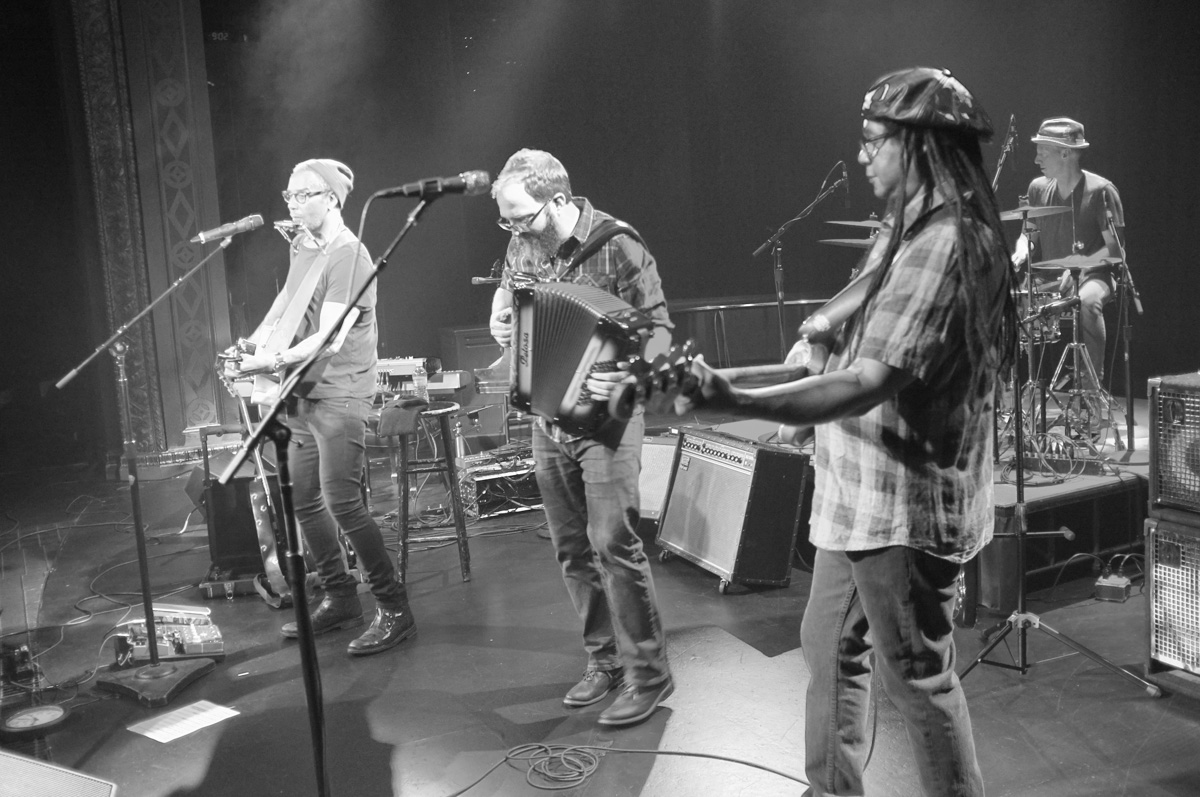
Leroy Bell & His Only Friends
Leroy Bell-Guitar, Vocals, Daniel Walker-Keyboards, Terry Morgan-Bass, Davis Martin-Drums,
After years of cover bands, and picking up day jobs Bell says “around 2000 I’d started getting itchy to sing and write again. I wanted to do my own thing again”.
LeRoy began doing solo dates and eventually contacted Terry Morgan for some assistance.
“I’d met Terry before. I didn’t know much about him, but I knew he booked groups, did productions and that kind of thing” Bell says, “so I contacted him and said ‘hey, would you be interested in booking me as a singer/songwriter?’ Then I sent him a demo tape and when I hear back from him he said yeah I’d be interested, but I’d want to play in the band”
During the 1980’s Terry Morgan, had been one of the original members of Modern Productions and had opened up the downtown Showbox to present some of the best punk/alternative shows Seattle had ever seen. When the original members of Modern Productions went their separate ways Morgan went on to book shows at the Paramount Theater the Showbox and other venues around town under the name Modern Enterprises, He also worked in band management, booked talent for Festival Sundiata, the Out-To-Lunch series of concerts and the Stillaguamish Festival of the River.
“Everybody in Seattle knows Terry”, LeRoy said…and it’s pretty close to the truth.
Terry remembers hearing from LeRoy around 2000;
“He was looking for some personal gigs, so I said ‘send me a demo’. We’d known each other since back in the ‘Bell and James’ days, but never really connected to do anything with him. it was just peripheral. I would go down and hang out at ‘Mighty Three Music’s’ office and was once at Kaye-Smith Studios during the Elton John recordings”.
“So LeRoy sent me a cassette” says Morgan” and I liked it-I really liked it! So I said look, ‘I really don’t want to manage any more bands after managing everybody in town”. I said ‘I’ll work with you under one condition, and that’s if I can play in the band. I just don’t want to be a hired-gun that gets tossed aside once you decide everything is good’.
“So we started playing together and I took over management”. Morgan says “Just putting things together”.“The first act I had him open for was Sergio Mendes at the Moore Theater.” That was about 17 years ago….2000 or 2001 at the latest”. Terry and LeRoy have worked together ever since. After his solo work, the band LeRoy Bell and His Only Friends was formed. With LeRoy at the center, surrounded by Terry Morgan on bass Davis Martin on drums, and Daniel Walker on keyboards. Later Davis Martin was replaced by Bill Ray on drums.
“From the beginning we started booking ourselves and played wherever we could” says Terry. “ “We had already been out touring with B.B. King, Etta James, Al Green and a number of other acts before LeRoy did X-Factor. We’d also been out with Leon Russell LeAnn Rimes, Los Lobos, Mavis Staples, The Temptations, The O’Jays, Roberta Flack, Idina Mendel, Bare Naked Ladies, India.Aire, Erykah Badu and Jonny Lang’.
I was aware of the British X-Factor”, Terry says “and over there you could be any age and you could do your own material. So I said “why not? What have we got to lose? The worst that could happen is you’d get on TV and seen by six million people”.
“So we did the auditions in Seattle, and then just waited and waited and waited and waited. Eventually he got the call. Then he went to L.A. for a week and they said ‘OK, we’ll call you back’ Then he got the third call and that was the beginning of it all. We did all the paperwork and legal stuff.
By the time LeRoy did his last appearance on the show he ended up in eighth place. He’d also found TV was a whole different thing than the music business he’d been working in for so long “but it turned out to be a good thing in some ways” he says.
One disappointment of appearing on the show was, unlike the British program, he was forced to sing familiar songs by other artists rather than show his skill as a songwriter. His voice caught the judges and audiences’ attention, but his real strength is in songwriting. In fact he’d already made a living through writing…and most of the audience weren’t even aware of the songs he’d written.
“After the show became really popular we got a request to go to South Africa” says LeRoy. “We played there as well. Terry and I made the trip. There’s a girl who’s really huge over there-Zahara-we did a live DVD with her, which was really really cool-and we ended up co-writing a song or two. It was kind of odd to be in such a different culture and walk down the street and have someone recognize you. That’s the magic of TV”
LeRoy and Terry did two shows with Zahara on June 8 and 9, 2012. The concert also included the Soweto Gospel Choir. When LeRoy, who was already well-known in South Africa, walked out on the stage the crowd went crazy. The concert was packaged as a DVD called ‘Zahara: The Beginning Live’ and it shipped double platinum. In 2013 it was nominated for a South African Grammy (SAMA) for “Best DVD, Live.
Bell admits he had to google her when he was first approached to work with Zahara. He told The Daily Sowetan
“She is an amazing singer who achieved success within a short space of time, a great singer and an accomplished songwriter. I got hold of her music, and simply fell in love with her voice”.
Zahara responded by admitting initially she nervous about the prospect of working with Bell as he is the same person who has written songs for music greats Michael Bolton, Elton John and the O’Jays, among other big international names.
“But since his arrival, the chemistry between us has been great” she said. “We connected easily when we were introduced. Now is the time to work, and I know that we will perhaps fight, as this is inevitable in a creative space, and as long as the fight will be for the improvement of the DVD that is fine with me. ‘I just love this man’s voice and the fact that I titled a song on my album’ Brand New Day’ just like he has done on his, this is simply an incredible coincidence,”
“Since then we were doing a lot of touring but the past two years we haven’t been touring as much”. Says LeRoy. “We’re playing much more regional. We haven’t been out with as many big names as we were for awhile. Many of them have passed away. We did a few dates with Steve Miller and quite a few dates with Huey Lewis. He’s still around and he has a great band. I don’t have anything against doing national tours, but it has to be the right kind of thing. We played the house of blues in Chicago. It was fun. We used to play with all the older guys, but it’s not the same”.
After so many years in the music business LeRoy is aware how much it has changed.
“It’s a completely different scene than it was. Some things stay the same but whole marketing is completely different now. Streaming and online and videos. When I was a kid it didn’t matter what a band looked like. Now it’s more what they look like than what they sound like.You can create any sound on your computer or your laptop. Then you get a check for 1000 plays for $2.”
It’s something young bands have come to accept.
“We’ve done about six albums and they do pretty well” He says “We sell them at the shows. We sell a lot better when we tour with the bigger acts, because you’re kind of co-opting their audiences. They’re used to buying the main acts merchandise or they may already have it. But we have our own label There are no middle men. You can really enhance your sales that way”.
“We’ve got some shows coming up and I’ve been writing for a new record. I’ve also been doing some online digital stuff, releasing directly to streaming services. I have a tiny studio at my house, so I can program and release “stuff, so I keep writing all the time”.
“I have a couple of songs streaming right now. One is ‘Who am I to U’, The other is ‘Stay Together’ Both are available at ‘Spotify’ and ‘i-tunes’ You can also find ‘Jaded’ off our last album, ‘When That Fire Rolls Around’.
After so many years in the business it’s clear LeRoy Bell and his Only Friends are in it for the long haul…maybe another 17 years. Meanwhile, they continue to work and though their gigs are regional right now, they’ll probably be out touring again when the situation is right. LeRoy admits that as he gets older he likes his comfort. It’s probably true of the rest of his crew. Every one of them are consummate musicians with decades of work behind them….so while they continue to play the Northwest, you might want to get out and see them soon.
LeRoy and His Only Friends will be appearing at:
Saturday April 14, 7:30 PM,The Marysville Opera House, Marysville WA
Saturday April 21 8:00 PM, Jazzbones, Tacoma WA
Saturday April 28, 9:00 PM, The Tractor Tavern, Seattle WA
Friday May 4, 7:00, Hillside House Concerts, Leavenworth WA
Saturday May 19, 10:00 PM, Sunbanks Festival at Sunbanks Resort, Electric City WA
Advance tickets are available at: http://leroybell.com/
-Dennis R. White. Sources: Dave Beck “Singer-Songwriter LeRoy Bell:The Rise, Fall And Rise Again KUOW.org,Mar 21, 2013); Tom Fitzgerald “A Hall of Fame hitmaker finds happiness and harmony in Bellingham”(Seattle Times, February 15, 2018); “LeRoy Bell and His Only Friends” leroybell.com, retrieved April 4, 2018); LeRoy Bell (X-Factor US Wiki, retrieved April 4, 2018); Erin K. Thompson “LeRoy Bell’s Breakout Year. And he’s only…60?” (The Seattle Weekly, December 6, 2011); Dennis R. White “LeRoy Bell Interview” (April 3, 2018); Eric Cerna “LeRoy Bell (Conversations At KCTS 9,Season 5 Episode 508, retrieved, April 3, 2018); Allison Corneau “5 Things You Don’t Know About 59-Year-Old X Factor Standout LeRoy Bell” (Us Weekly, October 7. 2011); Dennis R. White “Terry Morgan Interview” (April 6, 2018); Ed Hogan “Bell and James” (allmusic.com, retrieved April 6, 2018, retrieved April 4, 2018); Edward Tsumele and Patience Bambalel “Brand new day for Zahara and Leroy Bell” (Sowetan Live [ South Africa}, June 06, 2012); Paul Zollo “More Songwriters on Songwriting” De Capo Publishing, November 8, 2016); “How Thom Bell Rang Up The Hits For Philly International” (Billboard Magazine, June 16, 2006): Tom Phalen “ Lost Vuarnets Find Success Without Even Practicing” (The Seattle Times, October 8, 1993); Michael Paoletta and Lars Brandle “After U.K. Hit is U.S. Ready for Elton?” (Billboard, September 20, 2003)



